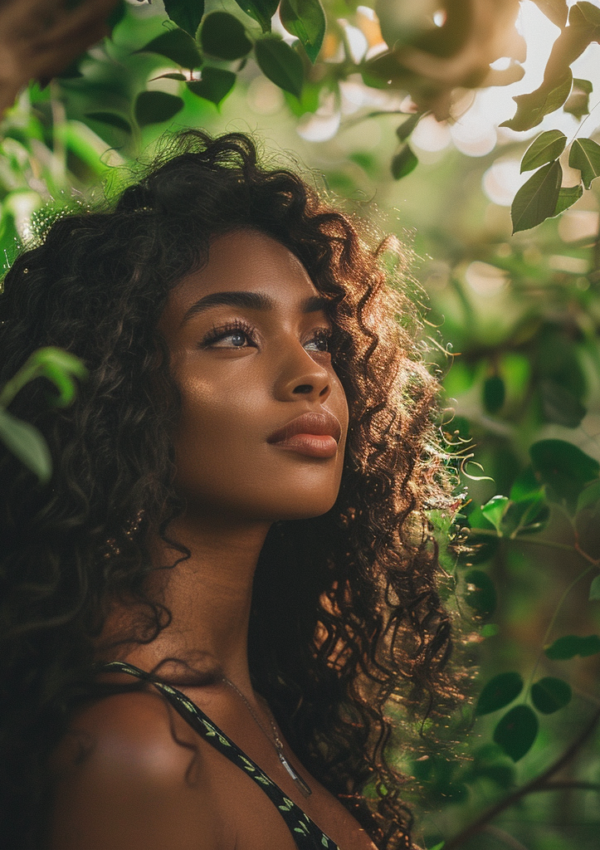Heads up! This post contains affiliate links. This means I may earn a small commission if you decide to make a purchase—at no additional cost to you. I only recommend products I’ve used and love. Thank you for supporting my blog 💕
💬 My Hair Story (And Why This Guide Matters)
Once upon a time, not that long ago I grew my natural hair to mid-back length, and I was so proud of that accomplishment. But I’ll be honest—I got a little too comfortable. I stopped deep conditioning regularly, I left my wigs in too long without checking on the hair underneath, and I definitely wasn’t moisturizing as I should have been.
The result? Breakage. Dryness. A whole lot of frustration.
So I hit reset. And now, as I work my way back to healthy, thriving curls, I’m sharing everything that’s helped me along the way—especially for my fellow Type 4 curly girls. If you’ve hit a plateau or feel like your hair isn’t growing past a certain point, this post is your personal roadmap to growth, retention, and real results.
🌾 A Shift Across Generations
A lot of us were raised by moms and grandmas who didn’t have the space—or the freedom—to fully embrace their natural hair. For them, textured hair was labeled “unkept,” especially in professional or formal spaces. This has led us to use products, chemicals, and styling tools & techniques that may have compromised the integrity of our hair’s health.
- My grandma grew up in the era of the press & curl.
- My mom? She was a Jheri curl queen.
- And me? My rite of passage into young womanhood was a relaxer.
That was just the norm. Straightened hair meant polished. Natural hair? That was “doing too much.”
But now, we live in a different time—and I’m so grateful for it. We have access to more education, more representation, and more resources than ever before to reconnect with our natural texture and learn how to properly care for it.
Sure, most of us have fried, dyed, and broken our hair off at some point. But now, we’re learning that there’s a better way. That long, healthy hair is possible—no matter the curl pattern or porosity.
Our hair is delicate, intricate, and she demands high-quality maintenance. She is not difficult—she is just misunderstood.
Let’s change that. 💕
🔍 My Hair Type: For Reference
Everyone’s hair is unique, but here’s what I’m working with:
- High Density (lots of strands per square inch)
- High Porosity (hair absorbs water quickly but loses it fast)
- Fine-Stranded (each strand is thin and delicate)
- Coily (4A/4B curl pattern)
Understanding your hair type is key to choosing the right products and techniques. If you’re not sure about your own, check out this quick guide on how to assess your:
- Density
- Curl pattern
- Porosity
- Strand texture
→ Explore Your Hair Type & Texture Guide
💡 Growth vs. Retention: What’s Really Going On?
Yes, your hair is growing. Even if you feel stuck, growth is happening at the root. The real issue is keeping that growth from breaking off.
Type 4 hair, with all its shrinkage, tangles, and delicate coils, is more prone to breakage. But once you understand your texture and give it what it needs—you’ll retain length like never before.
🚫 Common Length Retention Mistakes (That I Made Too)
Let’s be real. Here’s where most of us slip:
- Neglecting hair under wigs or protective styles
- Inconsistent moisturizing and sealing
- No regular trims = split ends take over
- Not protecting hair at night
- Wearing high-friction, unstretched styles too often
- Skipping protein or bond repair treatments
And for me? The biggest one was not stretching my hair. My fine, coily strands love being stretched. Constant shrinkage led to knots, tangles, and breakage.
That’s why I now embrace being a Straight Natural—roller sets, fluffy silk presses, blow-dried braid-outs. I stretch my hair in gentle, intentional ways, and my coils are thriving.
Tip #1: 💧 Moisture is Queen—but Consistency is the Throne
Type 4 hair is naturally dry. It’s just the way our strands are built. Our scalps produce oil, but because of the way our curls bend and coil, that oil doesn’t travel easily down the hair shaft. So keeping our hair moisturized—especially the ends—has to be intentional.
But it’s not just about slapping on a leave-in and hoping for the best. Moisture retention is about method, product, and consistency. That’s the part I’m still working on—making it a habit, not just a one-time fix.
What’s working for me lately:
- 💦 Hydrating Leave-In Conditioner — light enough for daily use, but rich enough to do the job
- 🌿 Moisturizing Deep Conditioner — gives me that soft, manageable feeling after wash day
- 💧 Continuous Spray Bottle — easy way to refresh without starting from scratch
- 🛍️ Satin Scrunchies — keeps my styles in place without drying out my ends
I follow the LCO or LOC method depending on what my hair needs that day. For high porosity hair like mine, I usually go with liquid, cream, oil because I need all the moisture I can get. I moisturize daily or every other day depending on how my hair feels and how I’m wearing it.
This part isn’t fancy, but it makes all the difference. Moisture is maintenance, and it’s how we hold onto the inches we work so hard to grow.
Tip #2: 🧴 Don’t Skip the Strength: Protein + Bond Builders 101
Moisture keeps our coils juicy and soft, but protein gives our strands the structure they need to withstand breakage. If you’ve been moisturizing like crazy but your ends are still splitting or your curls feel limp and lifeless—it’s time to strengthen from the inside out.
Let’s break down the two types of strengtheners you need to know about:
💡 Protein vs. Bond Builders—What’s the Difference?
- Protein treatments fill in weak spots in the outer layer of your hair shaft with keratin or amino acids. Think of them as surface-level reinforcements that help your hair bounce back and hold its shape.
- Bond builders (like K18 and Olaplex No. 3) go deeper. They repair internal bonds that are broken down by heat, color, or chemical damage. These are especially important if you’re a straight natural, regularly stretching or heat styling your hair.
Both are amazing—but in different ways. And yes, you can use both… with care. (More on that in a second 👇🏾)
🛑 Signs Your Hair is Begging for Protein:
- It feels mushy or overly soft when wet
- It breaks off with little to no tension
- It won’t hold styles like twist-outs or rod sets
- It feels lifeless or overly limp
🧬 What I Personally Use (and Recommend):
- K18 Leave-In Molecular Repair Mask – My holy grail post-heat styling or after a silk press. It brings my strands back to life—seriously.
- Olaplex No. 3 Hair Perfector – I use this before deep conditioning, especially after stretching or flat ironing.
- 🛍️ My Full Amazon List: Protein + Bond Builders – Browse all my faves in one place, from light protein treatments to intensive repair masks.
📌 Pro Tip: Use protein or bond builders on clean, product-free hair after shampooing, so they can actually penetrate the hair shaft.
🌀 How Often Should You Use Them?
- Light protein treatments: every 2–4 weeks
- Intensive protein (like Aphogee 2-step): every 6–8 weeks
- Bond builders: weekly or biweekly, especially if you use heat or color regularly
If your hair is in need of treatment, you should choose either protein OR bond builder on washday— not both at the same time as it could be too much for your hair.
📓 Use your Healthy Hair Regimen Tracker to stay on top of what you’ve used and when—so you don’t go overboard.
Tip #3: 💊 Nourish Your Hair from the Inside Out
Here’s the truth: you can’t out-condition a poor diet. If you’re not giving your body the building blocks for hair, it will prioritize other systems over your strands.
🥗 What your hair actually needs:
- Protein + amino acids (for keratin production)
- Eat: chicken, eggs, lentils, tofu, quinoa
- Iron & zinc (for circulation and scalp health)
- Eat: spinach, red meat, pumpkin seeds, beans
- Vitamin C (helps absorb iron)
- Eat: citrus fruits, strawberries, bell peppers
- Omega-3 fatty acids (reduce inflammation, improve follicle function)
- Eat: salmon, flax seeds, walnuts
- Biotin & B-complex vitamins
- Eat: whole grains, almonds, eggs
- Water — seriously, don’t skip this. Aim for 8+ cups a day.
👉 I personally take Mary Ruth’s Hair Growth Multivitamin daily, and it’s made a huge difference in both my hair and energy levels. You can find all my supplement faves here: → Hair Supplements & Vitamins Guide
Tip #4: 🧼 Wash Day = Your Reset Button (Even If You Keep Pushing It Back)
Confession time: I still struggle with putting off wash day. 🙈
I know weekly wash days are ideal—especially for high-porosity Type 4 hair—but I grew up either getting my hair braided to last for months, or heading to the salon every other week. There wasn’t this idea of regular maintenance, daily moisturizing, or pre-pooing. I just didn’t know.
And honestly? That old mindset is a hard habit to break.
Now that I’m deep into my natural hair journey, I realize that weekly wash days are not optional—they’re foundational. Especially when you want to retain length. Treat wash day like a chance to reset your hair’s health.
Pushing it back too far leads to:
- Product buildup
- Dry, tangled roots
- Matted sections
- Breakage from delayed detangling
- Neglect (even when unintentional)
Here’s how I make wash day easier (and less overwhelming):
My go-to routine:
- Pre-poo with oil or conditioner
- Detangle and work in sections, starting from the ends up. Keeping sections throughout washday helps keep hair manageable.
- Be gentle when shampooing— focus on the scalp first then down the hair to the ends. No scrambling your hair up and tangling it.
- Deep condition with heat every single wash day— with a hooded dryer, hair steamer, or processing cap.
- Apply protein or bond builder if needed
- Finish with a cool rinse to seal in moisture
- Moisturize & seal (LCO or LOC method)
- Stretch your hair with a gentle style
🛍️ My favorite tools for a smooth wash day:
- 🫧 Moisturizing Shampoo
- 💦 Deep Conditioner
- 🧴 Protein Treatment or Bond Builder
- 💨 Blow Dryer with Comb Attachment
- 🔥 Heat Protectant
- 🧴 Lightweight Sealing Oil
Even if you fall off track (like I still do sometimes!), the key is to always come back to it. Your wash day is your reset—and your opportunity to show your hair the love it deserves.
✨ Tip #5: Choose Low-Tension, Length-Retaining Styles That Actually Protect
Let’s get one thing straight: not all protective styles are created equal. Just because it’s called “protective” doesn’t mean it’s helping your hair thrive.
The goal isn’t just to tuck your hair away—it’s to protect it without stressing it out. That’s why low-tension, stretched styles are my go-to for maintaining length and keeping my coils healthy and happy.
My Favorite Low-Tension, Length-Retaining Styles:
- 💨 Blow-dried braid-outs (light stretch, low manipulation)
- 💅🏾 Fluffy silk presses (sparingly, and always with a good heat protectant)
- 🎀 Flexi-rod or perm-rod sets (no pulling, all definition)
- 🧶 African threading or banding (perfect for stretching without heat)
- 🥰 Low buns secured with satin scrunchies—simple and gentle
→ Need some inspiration? I’ll be dropping a full list of length-retention friendly styles in this upcoming post: Length Retention Protective Styles
🔑 Here’s What Makes a Style Truly Protective:
- Moisturize your hair before and during long-term styles
- Don’t skip scalp care just because it’s hidden—your scalp still needs love (and shampoo!)
- Avoid super tight braids or styles that tug at your edges
- Take breaks between installs so your scalp and strands can breathe
💬 I’ve learned the hard way: the tighter the style, the higher the risk of breakage. Your hair should feel secure—not stressed.
Low-tension doesn’t mean boring—it means intentional. When you combine protection with proper prep and care, your hair stays nourished, stretched, and ready to retain every inch you’ve worked for.
🛍️ Style helpers:
Tip #6: 🌙 The Nighttime Routine That Saves Your Ends
You did all the things—washed, deep conditioned, moisturized, sealed—and now you’re climbing into bed with your curls out and about?
Don’t do it, sis. 😭
Nighttime is when your hair is most vulnerable. You’re tossing, turning, lying on cotton sheets (aka moisture thieves), and all that friction can undo days of progress. If your goal is retention, your nighttime routine needs to be just as intentional as your wash day.
Here’s how to turn your nighttime ritual into a mini self-care moment for your strands:
✨ Bedtime Basics to Protect Your Hair (and Your Peace):
- Wrap it up right. Cover your hair in a soft satin bonnet or scarf. If you’re not into wrapping every night (been there), at least opt for a satin pillowcase—bonus: it’s great for your skin too.
- Use gentle accessories. Swap tight elastics for satin scrunchies to secure loose braids, pineapples, or twists. Less tension = less breakage.
- Moisture check. If your ends feel dry, spritz them with a little water + leave-in and seal with a light oil before bed. Hydrated ends are happy ends.
- Keep it loose. Styles that are too tight (especially at night) can lead to thinning edges, tension bumps, and long-term breakage. Let your scalp breathe while you sleep.
🧡 Pro Tip: Treat your nighttime routine like your hair’s beauty sleep. What happens overnight shows up in the morning—so tuck her in with love.
Tip #7: ✍️ Show Up for Your Hair—Consistently, Not Perfectly
Let me let you in on a little secret:
There’s no magic product that will save your hair if your habits aren’t in check.
You don’t need a 12-step routine. You don’t need to be perfect.
You just need to show up regularly.
And listen, I say this with love—because I’m still learning this too. Consistency is still the hardest part of my routine, but it’s also where the magic happens.
What’s really helping me stay on track:
- 🗓 Weekly check-ins with myself (Is my hair dry? Are my ends okay? How’s my scalp feeling?)
- 📸 Hair journaling & photo tracking—and not just for me. I actually track my whole family’s hair routines in one spot (because, yes, I’m that mom 😅)
- 🔁 Reassessing my products every 90 days to see what’s working and what’s not—our hair’s needs change, and our routines should too.
This journey isn’t about chasing perfection. It’s about being intentional, learning your hair, and staying consistent enough to see results.
🧾 That’s Why I Created the Hair Regimen Tracker
To make things easier (and a lot cuter), I created a free printable Hair Regimen Tracker to help you:
- Stay on top of your moisture & sealing schedule
- Track your protein treatments
- Remember wash days (because life gets busy)
- Check in on scalp health + length retention
- Keep notes on products you loved or hated
📥 Download Your Free Healthy Hair Regimen Tracker → [here]
🧡 Because when you track it, you take it seriously. And your hair deserves that.
💬 You Can Do This, Sis.
If your hair feels “stuck,” you’re not alone. I’ve had to rebuild, too. It’s frustrating, but it’s also a chance to reconnect with your crown and do it with love this time around.
Healthy hair isn’t about perfection—it’s about consistency, care, and confidence.
✅ Save this post
✅ Share it with your curlfriends
✅ Comment below: What’s ONE change you’re making today to help retain length?
You’ve got this 💪🏾✨
📎 Shop This Post
- 🛍️ Mary Ruth’s Hair Growth Multivitamin
- 🛍️ My Amazon Store: Straight Natural Must-Haves
- 🧴 Leave-In Conditioner
- 💧 Deep Conditioner
- 🧪 Olaplex No. 3
- 🧬 K18 Molecular Repair Mask
- 🔥 Heat Protectant
- 💤 Satin Bonnet + Pillowcase Set
- 🎀 Satin Scrunchies
- 📥 Free Hair Regimen Tracker









Leave a Reply